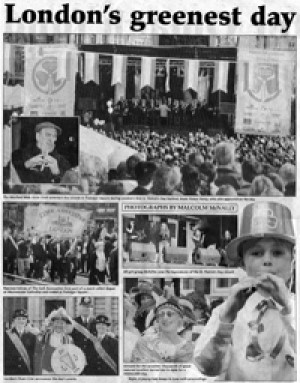The British-Irish
As any Brit with Irish ancestry knows, Irish family history has a serious blind spot. For the Irish in the U.S., Canada, Australia, New Zealand, even Argentina, there are migration histories aplenty, along with biographical dictionaries, passenger lists, dedicated websites, conferences, magazines. Yet despite the fact that over the past four centuries more Irish have migrated to Britain than to any other destination, there is almost nothing dealing with the genealogies of the Irish in Britain. Even the huge growth in the awareness of the Irish "Diaspora" since the 1980s seems to have passed over Britain in near-silence. Why should this be?
Simple proximity is one reason. Britain is just too close to count as true migration. From the seventeenth century, and even before, Irish individuals and families travelled back and forth, and long traditions of seasonal migration evolved. Over more than 150 years, for example, agricultural labourers from Achill and north Mayo travelled to Scotland every summer, and used what they earned to survive at home for the rest of the year. Such journeys were made easier from the mid-nineteenth century by the coming of the railways. Inevitably, semi- permanent Irish communities evolved. But this was not the enduring exile of America or Australia; home was only a few days' journey away, still a possibility. Even today, you can meet Irishmen in London who left in the great wave of emigration of the 1950s and in spite of everything think of their 40 or 50 years in England as a temporary stay. The fact is that, until 1922, Britain and Ireland were a single country, and the Irish Sea was more like an inland lake than an international boundary. Especially in Irish cities there were small but significant Scottish, English and Welsh communities, even as extreme poverty was creating much larger Irish communities in Britain.
Another, related, reason for the genealogical blind spot is the paucity of records. Crossing an international border, changing currencies and laws and citizenship - these all create records. Moving from Roscommon to Lancashire in 1872 may have involved a change of culture and language, but it produced no records, and without records research is simply not possible.
The blind spot has another explanation, however. Think of the ways in which the descendants of the Irish abroad are described: Irish-Americans, Irish-Canadians, Irish-Australians. Why does "Irish-British" sound like an absurd self-contradiction, at least to contemporary Irish ears? After partition in 1922, a monolithic, ferociously homogeneous state was created in the southern 26 counties, Catholic, Gaelic, nationalist, but above all else, not British, a self-identification shared to a large extent by the Catholic minority in Northern Ireland. A classic post-colonial syndrome, intensified in Ireland's case by the physical, economic and cultural closeness of Britain. You define yourself in opposition to what threatens you most. "Irish" simply became the opposite of "British".
This mind-set permeated Irish life throughout most of the 20th century. History was taught in two unrelated categories, Irish and European, with curious blanks when it came to anything British that did not impinge on Ireland. Geography was divided into Ireland and The World; to this day many Irish people who could pinpoint Timbuktu on a map have only the haziest notion of where places are next door in England. The Irish who fought in the two World Wars were wilfully forgotten. And the Irish abroad became Irish-America and Irish-Australia.
Things are changing, though slowly. The academic study of local Irish populations in Britain is uncovering the skein of connections between particular localities in Ireland and British destinations. We have Glasgow Irish, Liverpool Irish, Manchester Irish, London Irish. It will still take a while before we have British Irish.
